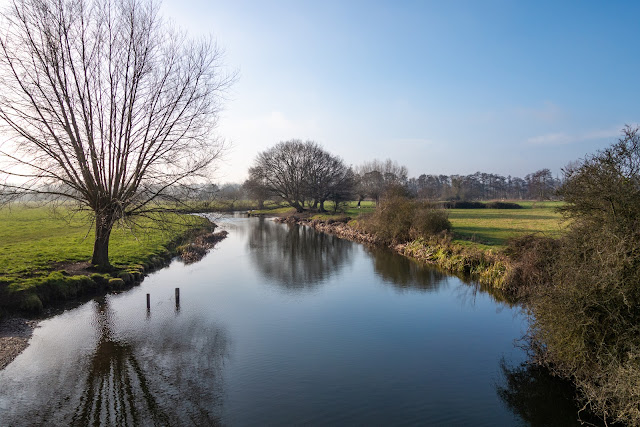A walk to picturesque Dedham
Set by the River Stour, Dedham is in the heart of Constable Country. It was here that Britain's greatest landscape artist John Constable went to school. The attractive high street is lined with Georgian-fronted houses, old inns and a large art and crafts centre. The magnificent 15th C. church was built from the wealth of the medieval cloth industry.
Dedham is frequently rated as containing some of England's most beautiful Lowland landscapes, particularly the Water Meadows of the River Stour, which passes along the northern boundary of the village forming the boundary between the counties of Essex and Suffolk.
So today we walked from Flatford, across these same meadows to Dedham.
The view we had from just outside Dedham on this beautiful sunny, but cold, morning.
Village signs always make me turn my head as they vary considerable, and some are just plain intriguing. I usually have to take the picture!
As we approached the main street we walked past this magnificent old building. It is 16th century, Grade II* listed building, sitting proudly at the centre of Dedham, and has been an inn since 1704.
It was named after the Duke of Marlborough who had enjoyed a famous victory over the French at the Battle of Blenheim in that year. And while landlords have come and gone, the name, and much of the pub, has stayed the same for more than 300 years.
John Constable attended the Grammar School in Dedham in the 1780s, after his initial education in Lavenham. The grammar school is now two private houses.
The present parish church of St Mary the Virgin, Dedham was built in the 15th century. Building work started in 1492, the year that Columbus discovered America, and St Mary's was completed 30 years later, before King Henry VIII made himself head of the Church in England.
The tower, completed in 1519, is actually an independent structure and is particularly imposing for a church of this size. It is said that Margaret Beaufort, mother of Henry VII, paid for the tower to be built. The tower is 131 feet high and is the most striking feature in this part of the Stour Valley.
Galilee Porch under St Mary Church tower. A Galilee is a chapel or porch at the west end of some churches where penitents waited before admission to the body of the church and where clergy received women who had business with them.
Many medieval Cistercian churches were entered through something called a Galilee or ‘paradise’. It was a porch situated on the west front of the church. It was an important starting point for religious processions into the church. It was also a popular place for patrons to be buried. In Rievaulx there are the remains of eight graves in the Galilee. There was often also a smaller altar. The Galilee porch at Tintern Abbey was said to house a miraculous image of the Virgin Mary.
These days it isn’t just monasteries and cathedrals that have Galilee porches. A number of parish churches have them as well, and this church is one such.
In Cistercian monasteries there was initially no place for lay visitors in the church during canonical hours and mass but it was recognised that visitors should be admitted on very holy days such as Easter, though historians are unclear where the guests sat once they were inside the church. The other thing to be remembered is that these guests were largely male as Cistercians took a dim view of women entering their precincts although they did provide hospitality to noble guests outside the abbey. How times change - thankfully!
The door allowing a view of the church interior from the Galilee Porch
Interior of Dedham Church looking toward the east end and the high altar.
Pew end - The American Connection with Dedham, Massachusetts
Many residents of Dedham and surrounding villages emigrated to the United States of America, some settling in Massachusetts. In 1636, the town of Dedham, Massachusetts was founded, taking its name from Dedham, Essex. From that time the links between Dedham, Essex, and descendants of early settlers in the USA have remained strong.
Shields in the Nave Roof, a dedicated Nave Pew and a Sealed Resolution in the Vicar's Vestry all mark the connection between Dedham, Essex and Dedham, Massachusetts
Here is the Nave pew mentioned above.
The Nave roof with its shields.
Wandering through the village, I was drawn to this rather small door. I could knock my head every time I entered I am sure!
To finish, a reflection on the source of the wealth that once made this pretty village - wool. Sheep browsing in a field on the edge of the village.

















Comments